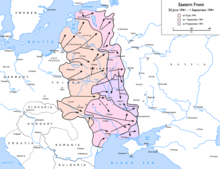
Back معركة أومان Arabic اومان دؤیوشو AZB Битка при Уман Bulgarian Batalla d'Úman Catalan Kesselschlacht bei Uman German Μάχη της Ουμάν Greek Batalla de Uman Spanish نبرد اومان Persian Umanin taistelu Finnish Bataille d'Ouman French
| Battle of Uman | |||||||
|---|---|---|---|---|---|---|---|
| Part of the Operation Barbarossa and Eastern Front of World War II | |||||||
 The eastern front at the time of the Battle of Uman. | |||||||
| |||||||
| Belligerents | |||||||
|
|
| ||||||
| Commanders and leaders | |||||||
|
|
| ||||||
| Units involved | |||||||
|
|
| ||||||
| Strength | |||||||
|
400,000 600 tanks |
300,000 317 tanks | ||||||
| Casualties and losses | |||||||
|
Total: 20,853[a] Killed: 4,610 Wounded: 15,458 Captured or missing: 785 |
Total: 203,000 Killed or wounded: 100,000 Captured: 103,000 Captured or destroyed: 317 tanks | ||||||
The Battle of Uman (15 July – 8 August 1941) was the World War II German offensive in Uman, Ukraine against the 6th and 12th Soviet Armies. In a three-week period, the Wehrmacht encircled and annihilated the two Soviet armies.
The battle occurred during the Kiev defensive operation between the elements of the Red Army's Southwestern Front, retreating from the Lwow salient, and German Army Group South, commanded by Field Marshal Gerd von Rundstedt, as part of Operation Barbarossa.
The Soviet forces were under overall command of the Southwestern Direction, commanded by Marshal Semyon Budyonny, which included the Southwestern Front commanded by Colonel General Mikhail Kirponos and Southern Front commanded by General Ivan Tyulenev. The 6th army was commanded by Lieutenant General I. N. Muzychenko and the 12th army by Major General P. G. Ponedelin.
Cite error: There are <ref group=lower-alpha> tags or {{efn}} templates on this page, but the references will not show without a {{reflist|group=lower-alpha}} template or {{notelist}} template (see the help page).